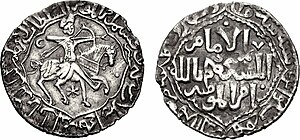| Kilij Arslan IV | |||||
|---|---|---|---|---|---|
 Rare coin minted under Kilij Arslan IV at Sivas in 1248/49 | |||||
| Sultan of Rum | |||||
| Reign | 1246/1249–1254[1] (first rule) 1257–1266 (second rule) | ||||
| Co-sultans | Kayqubad II (1249–1254) Kaykaus II (1249–1254) and (1257–1262) | ||||
| Predecessor | Kaykhusraw II | ||||
| Successor | Kayqubad II | ||||
| Predecessor | Kayqubad II | ||||
| Successor | Kaykhusraw III | ||||
| Born | 1237 or 1240 | ||||
| Died | 1265 (aged 25 or 28) | ||||
| Consort | Gumaḉ Khatun[2] Fatima Khatun Gazalya Khatun | ||||
| Issue | Saljuk Khatun, Kaykhusraw III | ||||
| |||||
| House | Seljuk | ||||
| Father | Kaykhusraw II | ||||
| Mother | A Greek concubine[1] | ||||
| Religion | Islam | ||||
Kilij Arslan IV (Old Anatolian Turkish: قِلِج اَرسلان) or Rukn ad-Dīn Qilij Arslān ibn Kaykhusraw (Persian: رکن الدین قلیچ ارسلان بن کیخسرو) was Seljuk Sultan of Rûm after the death of his father Kaykhusraw II in 1246.
However, a jarlig issued by Güyük Khan confirmed him as sultan over his elder brother, Kaykaus II in 1248.[3] But this jarlig would quickly be worthless after Güyük's death in the same year. Later, Arslan's supporters killed Shams al-Din Isfahani, a supporter of his brother, Kaykaus II (a rival to the throne). The death of Isfahani's successor in 1254, Jalāl-al-Din Qaraṭāy, left a power vacuum which was filled by competition by supporters of the two brothers. Eventually, Kaykaus II would emerge the victor in 1256.[4]
In the 1260s, Mu'in al-Din Parwana redistributed Seljuk crown lands among his followers. He did this to secure his position but would be met with protests from Arslan. This eventually led to Arslan's execution in 1265 by Parwana.[4]
- ^ a b "KILICARSLAN IV (ö. 664/1266) Anadolu Selçuklu sultanı (1249-1254, 1257-1266).". TDV Encyclopedia of Islam (44+2 vols.) (in Turkish). Istanbul: Turkiye Diyanet Foundation, Centre for Islamic Studies. 1988–2016.
- ^ Yetkin 1961, p. 360.
- ^ Saunders 2001, p. 98.
- ^ a b "Saljuqs". iranicaonline.org. Retrieved 2022-07-11.